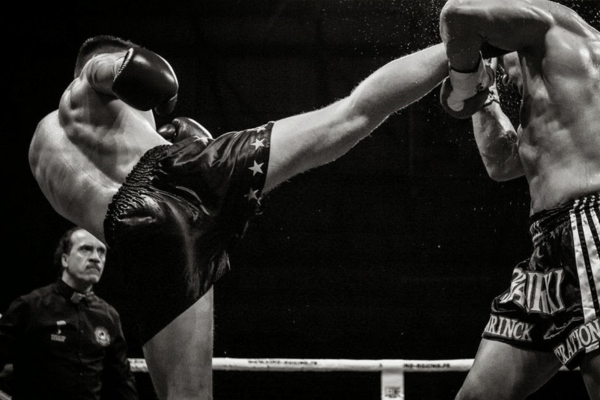The evolution of rules in kickboxing

Kickboxing is one of the most popular combat sports in the world today. It is a dynamic mix of speed, power and technique, where punches and kicks come together in an intense fight. But the kickboxing we know today has come a long way. The rules and structures of the sport have been continually modified over the years to improve safety, fairness and spectacle.
In this blog, we delve into the history of kickboxing and examine how the evolution of the rules has helped shape the sport. From the rise of modern kickboxing in the 1960s to today’s major organizations like GLORY and ONE Championship — the rules have shaped kickboxing into what it is today.
The origins of kickboxing and the first rules
Kickboxing originated in the 1960s in Japan and the United States. It was born from a fusion of traditional Muay Thai techniques and Western boxing techniques. While Muay Thai fighting often revolved around elbows and knees, early kickboxing restricted or banned many of these techniques to make fighting more accessible to a Western audience.
In the early matches, there was hardly any protective equipment and the rules were minimal. Fights were fought without shin guards and sometimes even without gloves. The focus was mainly on knockouts and showing physical superiority, which increased the risk of serious injuries.
In the 1970s, the first official kickboxing organizations were founded, such as the Professional Karate Association (PKA) and the World Kickboxing Association (WKA). They introduced rules that made the sport safer and more structured. For example, shin guards and gloves were made mandatory and the number of rounds per match was limited to reduce the physical strain on the fighters.
The rise of full contact kickboxing
While kickboxing was often practiced as a semi-contact sport in its early years (where points were awarded for well-placed techniques without full power), a shift to full-contact competitions occurred in the 1980s. Full-contact kickboxing brought more intensity and spectacle, but also increased the risk of injury.
To ensure the safety of the fighters, additional rules were added. For example, it became mandatory to wear a mouth guard, head protection and a tok during matches. Also, clinching (holding the opponent) was restricted or banned in many competitions to promote the speed of the fight.
The introduction of K-1 in the 1990s changed kickboxing dramatically. K-1 introduced a tightly regulated format that rewarded knockouts and limited clinching to a few seconds. This made the fight faster and more attractive to the audience. The K-1 rules are still used in many professional kickboxing organizations today.
Safety measures and medical checks
As kickboxing became more professional, so did the awareness of fighter safety. In the 2000s, strict medical checks and mandatory rest periods after knockouts were introduced. Fighters are now required to undergo a medical check-up before each fight and are checked for injuries afterward.
These measures are intended to reduce the chance of permanent injury. The number of rounds per match was also limited to a maximum of five, to prevent overload and exhaustion.
The introduction of better gloves and shin guards has made the sport safer without diminishing the spectacle. Modern gloves contain multi-layered foam that better absorbs shock, while shin guards are light and flexible, yet offer sufficient protection against hard kicks.
GLORY and ONE Championship: The modern standards

Founded in 2012, GLORY has played a major role in professionalizing kickboxing. The organization introduced strict weight classes, uniform rules, and a structured tournament format. GLORY matches usually consist of three rounds of three minutes, with an extra round in case of a draw.
GLORY also has a strict policy against illegal techniques such as back attacks or holding the opponent, which keeps the fights fair and limits injuries.
ONE Championship has merged kickboxing with Muay Thai, allowing elbows and clinching in certain matches. This creates a hybrid style that combines the best of both worlds and makes it more technically interesting for both fighters and the audience.
The future of rules in kickboxing
Technology is playing an increasingly important role in kickboxing, with the use of VAR (Video Assistant Referee) to review controversial decisions and the use of advanced biometric monitoring to better monitor the health of fighters.
Organizations are also experimenting with new competition formats, such as team fights and adjusted weight classes, to bring more dynamism and diversity to the sport. The focus on safety is likely to continue to increase. The number of rounds and duration of fights may be further adjusted, and more investment is being made in better protective equipment and training techniques to prevent injuries.
From brute force to technical perfection
The evolution of kickboxing rules has made the sport safer, fairer and more attractive. Where brute force used to be the deciding factor, it is now all about technique, tactics and speed. The balance between spectacle and safety has never been better.
Want to start kickboxing yourself or refine your technique? Check out our range of kickboxing equipment and train like a pro!
What do you think is the most important rule in modern kickboxing? Let us know in the comments!
 Nederlands
Nederlands English
English Deutsch
Deutsch Français
Français



Mooi om te lezen hoe de regels zijn geëvolueerd. Denken jullie dat het beperken van clinchen de sport beter heeft gemaakt, of juist een stukje authenticiteit heeft weggenomen?
Leave a comment